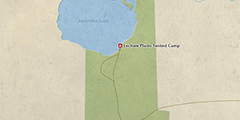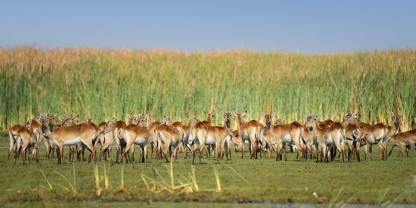Lochinvar National Park is renowned as a fantastic birding destination; waterbirds, especially, are abundant on Chunga Lagoon. This area is also home to large herds of the endemic Kafue lechwe, and you’ll enjoy seeing these water-loving antelopes splashing through the wetland. Also of interest is Gwisho hot springs and several massive baobab trees.

-
Best Time To Go
- December to April (Excellent birding)
-
High Season
- Never (The park is rarely visited)
-
Size
- 428km² / 165mi²
-
Altitude
-
978-1,053m /3,209-3,455ft
 View Photos
View Photos
 View Photos
+6
Photos
View Photos
+6
Photos
 Open Map
Open Map
Pros & Cons
- Great birding destination with over 420 species recorded
- Home to big herds of the endemic Kafue lechwe
- Off-the-beaten-track destination
- Unguided walking is allowed
- No accommodation or other facilities
- Low wildlife densities and little variety
- Very limited access to Chunga Lagoon and no boat trips
- Limited game-drive network
- Gypsum mine in the park
Wildlife
Aside from the Kafue lechwe, which sticks to the floodplains, you’re not likely to see much wildlife in Lochinvar. However, you might come across some other antelopes, such as oribi, grey duiker, bushbuck and the stately greater kudu. Vervet monkeys are always a treat to watch and you might spot a slender mongoose crossing the road too.
More about Lochinvar’s wildlifeScenery
Lochinvar is located on the southern edge of the Kafue Flats, a vast swampy floodplain fed by the Kafue River. The wetland also includes the open waters of the Chunga Lagoon, which is the focal point for birding and seeing the lechwe. To get there you’ll drive through woodland and grassland dotted with termite mounds.
Weather & Climate
Located in the tropics, Lochinvar experiences uniformly hot temperatures for most of the year. This pattern is only broken in October when the temperature lifts even more to greet the start of the Wet season (November to April). A slight cooling down occurs in the middle of the Dry season (May to October).
More about the weather and climateBest Time To Visit
Lochinvar can be visited throughout the year, but the wet summer months are best for bird watching, which is the main attraction of the park. From December onwards, the floodplains transform to a wetland brimming with birdlife. Migrants add to the resident species and many birds are in breeding plumage. Note though that road conditions deteriorate during the rains.
More about the best time to visit
